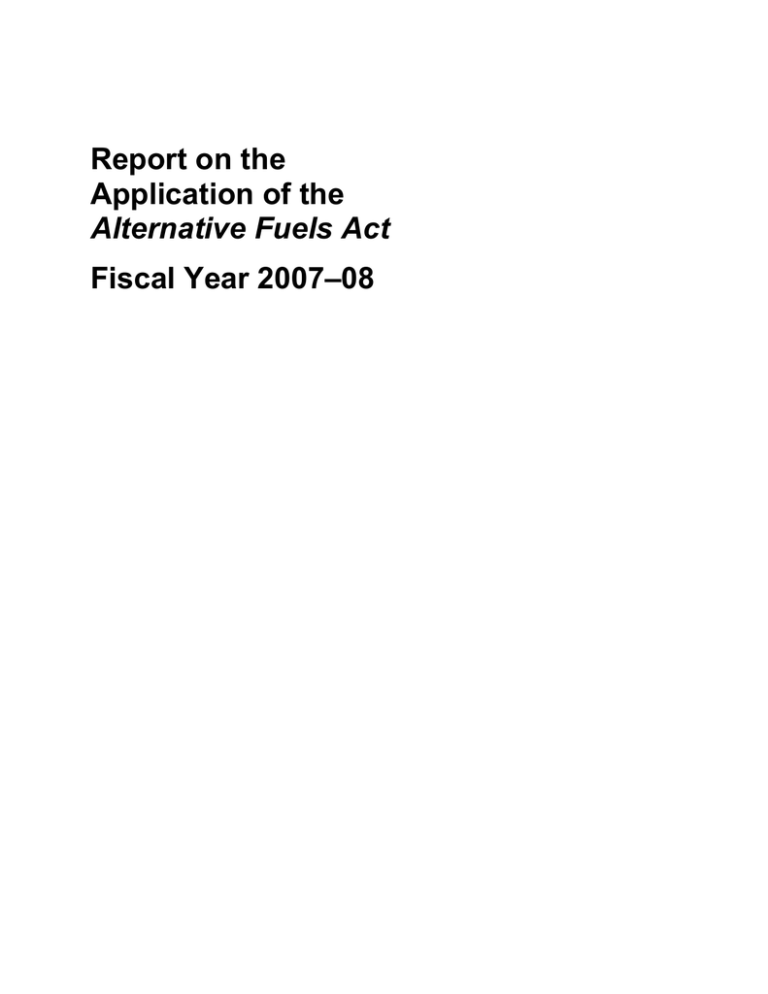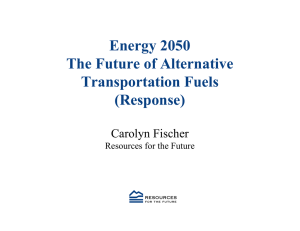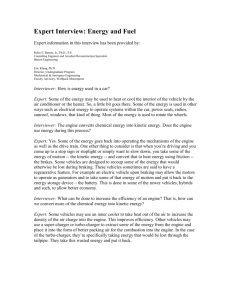Report on the Application of the Fiscal Year 2007–08 Alternative Fuels Act
advertisement

Report on the Application of the Alternative Fuels Act Fiscal Year 2007–08 © Her Majesty the Queen in Right of Canada, represented by the President of the Treasury Board, 2008 Catalogue No. BT76-1/2008 ISBN 978-0-662-05960-8 This document is available on the Treasury Board of Canada Secretariat website at http://www.tbs-sct.gc.ca. This document is also available in alternative formats on request. President’s Message I am pleased to table in Parliament the annual Report on the Application of the Alternative Fuels Act, for the fiscal year 2007–08, pursuant to the Alternative Fuels Act. _______________________________________ The Honourable Vic Toews, P.C., Q.C., M.P. President of the Treasury Board Table of Contents Executive Summary .............................................................................. i 1. Introduction ................................................................................... 1 1.1 Alternative Fuels Act ................................................................. 1 2. Compliance with the Alternative Fuels Act........................................... 1 2.1 New vehicle acquisitions ............................................................ 2 2.2 Use of alternative transportation fuels in the federal fleet ............... 2 2.3 Cost-effectiveness and operational-feasibility constraints ............... 2 2.4 Mitigating measures.................................................................. 3 2.5 Use of hybrid gasoline-electric vehicles in the federal fleet.............. 4 3. Conclusion ..................................................................................... 5 Appendix 1: Terminology ...................................................................... 6 Appendix 2: New Vehicle Acquisitions ..................................................... 8 Executive Summary Annual Report on the Application of the Alternative Fuels Act The Alternative Fuels Act (AFA) requires the President of the Treasury Board to report annually on the application of the AFA in respect of all federal bodies (departments and agencies) named in schedules I, I.1, and II of the Financial Administration Act (FAA). This is the eleventh annual report on the application of the AFA. The Alternative Fuels Act The purpose of the AFA is to accelerate the use in Canada of alternative transportation fuels in motor vehicles to reduce the emission of carbon dioxide and other greenhouse gases, thereby lessening dependence on petroleum-based fuels for transportation. These alternative fuels include ethanol, methanol, propane gas, natural gas, hydrogen, or electricity, which must be used as the sole energy source for direct propulsion. Compliance with the Alternative Fuels Act For the eleventh consecutive year, the federal government, through the activities of the federal bodies named in schedules I, I.1, and II of the FAA, exceeded AFA acquisition requirements, which prescribe that 75 per cent of all new vehicles be deemed both cost-effective and operationally feasible to run on alternative fuels. In the aggregate, the federal government acquired 1,554 alternative fuel vehicles during 2007–08—each one capable of operating on E85 ethanol fuel. Conclusion The limited availability of alternative fuel vehicles and a lack of supporting infrastructure throughout Canada have constrained the ability of the federal government to increase the usage of these vehicles in its fleet. The rising cost of petroleum-based fuels and technological and commercial developments over time should address these constraints. Meanwhile, the federal government has continued to meet the objective of the AFA through several mitigating measures: the acquisition of vehicles that can operate on both petroleum-based and alternative fuels; the application of environmental criteria in the evaluation of bids for federal vehicles; and policies that require the purchase of E10 gasoline where available and the elimination of unnecessary idling. Also, modernization of the federal fleet with newer, cleaner, and more fuel-efficient vehicles has also led to a significant reduction in greenhouse gas and harmful ground-level emissions. ANNUAL REPORT TO PARLIAMENT i 1. Introduction The Alternative Fuels Act (AFA) requires the President of the Treasury Board to report annually on the application of the AFA by all federal bodies (departments and agencies) named in schedules I, I.1, and II of the Financial Administration Act (FAA). This is the eleventh annual report on the application of the AFA. 1.1 Alternative Fuels Act The AFA received Royal Assent on June 22, 1995, and took effect on April 1, 1997. The purpose of the AFA is to accelerate the use in Canada of alternative transportation fuels in motor vehicles to reduce the emission of carbon dioxide and other greenhouse gases, thereby lessening dependence on petroleum-based fuels for transportation. These alternative fuels include ethanol, methanol, propane gas, natural gas, hydrogen, or electricity, which must be used as the sole energy source for direct propulsion. The AFA and the Alternative Fuels Regulations require that, where cost-effective and operationally feasible, 75 per cent of all motor vehicles operated by federal departments and agencies use alternative fuels. More specifically, the AFA requires that: of the portion of newly acquired vehicles deemed both cost-effective and operationally feasible to run on alternative fuels, 75 per cent must be physically capable of using these fuels; and when it is cost-effective and operationally feasible, a federal body shall use an alternative fuel in the operation of any motor vehicle capable of operating on such a fuel. 2. Compliance with the Alternative Fuels Act Treasury Board policy requires departments and agencies to comply with the AFA when making motor vehicle procurement decisions. Supporting guidelines provide additional information to ensure effective application of the AFA and the Alternative Fuels Regulations and assist departments and agencies with meeting their AFA obligations. In complying with the obligations of the AFA, departments and agencies have been restricted by the limited availability of alternative fuel vehicles for purchase and by a lack of supporting infrastructure throughout Canada. Under these conditions, operating federal government vehicles on alternative fuels is not cost-effective and is only operationally feasible in select areas where a supporting infrastructure exists. Nevertheless, in support of the objective of the AFA, the federal government has taken mitigating measures to reduce greenhouse gas emissions and increase the ANNUAL REPORT TO PARLIAMENT 1 Alternative Fuels Act viability of using alternative transportation fuels in its fleet. Details on these measures are provided in section 2.4. 2.1 New vehicle acquisitions The federal bodies named in schedules I, I.1, and II of the FAA acquired a total of 4,747 vehicles during 2007–08, of which 1,554 were alternative fuel vehicles, far exceeding any previous totals reported under the AFA. All new factory-produced alternative fuel vehicles acquired during 2007–08 were ethanol 85/gasoline (E85) flexible fuel vehicles that are capable of running on gasoline alone or on any blend of gasoline and ethanol, up to a maximum of 85 per cent ethanol. 2.2 Use of alternative transportation fuels in the federal fleet The federal government’s 19 natural gas vehicles (down from 48 in 2006–07) consumed approximately 56,936 kg of natural gas, and its 31 propane vehicles (down from 55 in 2006–07) consumed approximately 101,239 litres of propane. While only a portion of the federal government’s 2,898 E85 flexible fuel vehicles had immediate access to E85 fuel during 2007–08, those that had access to this fuel consumed approximately 573,869 litres. The federal government has also made use of low-level blended fuels, consuming 4.8 million litres of E10 gasoline and 271,203 litres of biodiesel. 2.3 Cost-effectiveness and operational-feasibility constraints During 2007–08, there were a number of cost-effectiveness and operational-feasibility constraints that limited the acquisition of alternative fuel vehicles and challenged the viability of using alternative transportation fuels in the federal fleet. There continued to be a limited supply of factory-produced alternative fuel vehicles in all classes that are suitable for federal government operations. The cost per litre of E85 fuel in Canada was, on average, approximately 12 per cent higher than it was for regular gasoline, and the lower energy content of E85 fuel compared to regular gasoline resulted in a consumption of approximately 25 per cent more E85 fuel than regular gasoline to travel the same distance. There were only two fuelling stations that offered E85 fuel commercially in Canada. Both were in Ontario in regions located outside of main operating areas of federal vehicles. 2 Outside of urban areas, supplies of propane and natural gas remain limited and the operating hours of suppliers are often restricted. Some jurisdictions restrict the use of propane vehicles in certain areas, e.g. underground parking garages and some airport tarmacs. The installation of alternative fuel tanks in vehicles sometimes affects their operational capabilities because it reduces available cargo space. The effectiveness and quality of after-market conversion kits for propane and natural gas remain questionable. In fact, testing has sometimes revealed a higher quantity of emissions than from gasoline vehicles. Also, some departments noted that the limited number of approved warranty service facilities for converted vehicles has resulted in higher maintenance and repair costs. Consequently, no federal vehicles were converted to alternative fuel use during 2007–08. 2.4 Mitigating measures Despite the factors listed above, the federal government endeavoured to meet the objective of the AFA to accelerate the use in Canada of alternative transportation fuels in motor vehicles to reduce the emission of carbon dioxide and other greenhouse gases. This was accomplished through several mitigating measures. The federal government continued to make use of the 14 E85 ethanol fuelling tanks installed on its own sites across Canada, thus increasing the viability of alternative fuel usage in the regions where the tanks are installed. The increase in the number of flexible fuel vehicles purchased by the federal government was mainly due to a broader selection of these vehicles in the classes that were suitable for its operations. Until such operational constraints as the limited alternative fuel infrastructure are alleviated, the federal government runs flexible fuel vehicles on E85 ethanol where this fuel is available and on regular and E10 fuel where it is not. As a measure to further reduce greenhouse gas emissions from the federal fleet of vehicles, environmental criteria apply to the purchase of most passenger cars, minivans, and station wagons. These criteria provide an advantage to alternative fuel and hybrid gasoline-electric vehicles as well as vehicles equipped with fuel-efficient four-cylinder engines. Treasury Board policy requires departments and agencies to fill up with E10 fuel whenever possible and to take measures to eliminate unnecessary idling. ANNUAL REPORT TO PARLIAMENT 3 Alternative Fuels Act These measures articulate the federal government’s commitment to meeting the objective of the AFA in a practical manner that takes advantage of opportunities to demonstrate environmental leadership despite cost-effectiveness and operational-feasibility constraints. 2.5 Use of hybrid gasoline-electric vehicles in the federal fleet Hybrid gasoline-electric vehicles are not considered alternative fuel vehicles under the AFA and, as such, are not included in the total of 1,554 vehicles discussed in section 2.1 of this report. As many hybrid gasoline-electric vehicles meet federal operational needs, the federal government ordered 195 of these vehicles during 2007–08 (see table below) and now operates an estimated total of 1,075 of them. Department or Agency 4 Number of Hybrid Gas-Electric Vehicles Acquired Agriculture and Agri-Food Canada 1 Atlantic Canada Opportunities Agency 2 Canada Border Services Agency 8 Canadian Food Inspection Agency 5 Correctional Service Canada 2 Economic Development Agency of Canada for the Regions of Quebec 1 Environment Canada 4 Fisheries and Oceans Canada 7 Foreign Affairs and International Trade Canada 6 Health Canada 8 Indian and Northern Affairs Canada 2 Industry Canada 1 National Defence 6 National Energy Board 1 National Parole Board 3 Natural Resources Canada 6 Parks Canada 4 Privy Council Office 3 Public Safety Canada 1 Public Works and Government Services Canada 5 Department or Agency Number of Hybrid Gas-Electric Vehicles Acquired Royal Canadian Mounted Police 83 Transport Canada 36 Total 3. 195 Conclusion During 2007–08, the federal government, through the activities of the federal bodies named in schedules I, I.1, and II of the FAA, exceeded AFA requirements governing vehicle acquisition. However, the constraint on the availability of alternative transportation fuels and lack of supporting infrastructure throughout Canada during this period resulted in a limited use of these fuels. The rising cost of petroleum-based fuels and technological and commercial developments over time should address these constraints. Meanwhile, the federal government has continued to meet the objective of the AFA to accelerate the use of alternative transportation fuels in Canada by acquiring vehicles that can operate on both petroleum-based and alternative fuels, which better positions its fleet should changes occur in the infrastructure and in the cost of alternative transportation fuels. It is important to note that expanding the use of alternative transportation fuels and alternative fuel vehicles is but one of many measures taken by the federal government to reduce greenhouse gas emissions from its fleet. For example, environmental criteria are used in the evaluation of bids for federal vehicles, giving an advantage to hybrid gasoline-electric and alternative fuel vehicles as well as vehicles with fuel-efficient four-cylinder engines. Furthermore, Treasury Board policy requirements on buying E10 fuel where available and eliminating unnecessary idling also result in lower emissions. And finally, modernization of the federal fleet with newer, cleaner, and more fuel-efficient vehicles has also led to a significant reduction in greenhouse gas and harmful ground-level emissions. ANNUAL REPORT TO PARLIAMENT 5 Alternative Fuels Act Appendix 1: Terminology The following section provides definitions of the terms frequently used in this report: Motor vehicle For the purposes of reporting on the AFA, motor vehicle is understood to include automobiles, passenger vans, light- or medium-duty trucks, and buses. Alternative transportation fuel Under the AFA, alternative transportation fuel, or alternative fuel, must include, but is not limited to, ethanol, methanol, propane gas, natural gas, hydrogen, or electricity, and these must be used as a sole source of direct propulsion energy. For the purpose of acquiring motor vehicles, the Alternative Fuels Regulations expand the definition of alternative transportation fuel given above to include blended fuels when an alternative fuel (as defined above) makes up at least 50 per cent of the blend. Flexible fuel and bi-fuel vehicles are also considered to be alternative fuel vehicles for the purposes of acquiring motor vehicles. For the purposes of using alternative transportation fuels, the Alternative Fuels Regulations also expand on the definition of alternative transportation fuels given above to include biodiesel and blended fuels that include any amount of the approved alternative transportation fuel. Flexible fuel vehicle A flexible fuel vehicle is one with a single fuel system that operates on one of two different fuels alone or on a blend of the two (e.g. an E85 vehicle can operate on gasoline alone or on any blend of gasoline and ethanol, up to a maximum of 85 per cent ethanol). Cost-effective A vehicle is considered cost-effective for alternative fuel use if it can be demonstrated that the additional cost of either converting a vehicle to use alternative fuels or acquiring a factory-produced alternative fuel vehicle will be recovered in the form of fuel savings over the life of the vehicle. Where net savings are greater than $1, a vehicle is considered cost-effective for alternative fuel use. 6 Operationally feasible Alternative transportation fuel use is considered to be operationally feasible when it can be demonstrated that the vehicle will be able to fulfill its primary operational tasks. The definition of operational feasibility will vary across departments and agencies according to a wide range of variables, including the following: the specific travel patterns of each vehicle, the mandate of the department or agency, the availability of alternative transportation fuels wherever the vehicle will travel, the local laws (or by-laws), the vehicle performance requirements, and the vehicle availability or the availability of a suitable conversion kit. ANNUAL REPORT TO PARLIAMENT 7 Alternative Fuels Act Appendix 2: New Vehicle Acquisitions The table below lists, by department or agency, new vehicle acquisitions under the application of the AFA for 2007–08. The information reported is the result of consultations with each department and agency. Departments and agencies included in schedules I, I.1, and II of the FAA but not listed below did not acquire any new vehicles during 2007–08. Department or Agency Total Number of Vehicles Acquired Number of Alternative Fuel Vehicles Acquired Schedule I Agriculture and Agri-Food Canada 16 1 Canadian Heritage 2 0 Citizenship and Immigration Canada 4 0 75 5 316 21 11 3 105 26 Indian and Northern Affairs 26 1 Industry Canada 13 2 1,028 322 51 21 1 0 Public Works and Government Services Canada 33 18 Transport Canada 94 27 Veterans Affairs Canada 6 3 Western Economic Diversification Canada 1 1 1,782 451 Environment Canada Fisheries and Oceans Canada Foreign Affairs and International Trade Canada Health Canada National Defence Natural Resources Canada Public Safety Canada Totals for Schedule I 8 Department or Agency Total Number of Vehicles Acquired Number of Alternative Fuel Vehicles Acquired Schedule I.1 Atlantic Canada Opportunities Agency 3 1 Canadian Grain Commission 2 2 Canadian International Development Agency 2 1 281 127 Courts Administration Service 1 0 Economic Development Agency of Canada for the Regions of Quebec 7 0 Library and Archives Canada 3 2 National Energy Board 1 0 National Parole Board 11 0 Privy Council Office 7 2 Registrar of the Supreme Court of Canada 1 0 Royal Canadian Mounted Police 2,364 874 Totals for Schedule I.1 2,683 1,009 Department or Agency Total Number of Vehicles Acquired Number of Alternative Fuel Vehicles Acquired Correctional Service Canada Schedule II Canada Border Services Agency 125 67 6 3 23 8 Canadian Nuclear Safety Commission 1 0 National Battlefields Commission 3 0 National Research Council Canada 21 6 Parks Canada 99 10 4 0 282 94 4,747 1,554 Canada Revenue Agency Canadian Food Inspection Agency Transportation Safety Board of Canada Totals for Schedule II Totals for all Schedules ANNUAL REPORT TO PARLIAMENT 9







